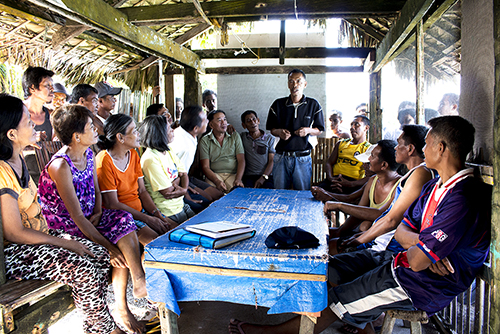
Abello Frias is an Industrial Engineering graduate. He has four children with his wife, Novelita Frias, a school teacher in Masbate. He was previously employed in Manila but decided to finally join his family in the coastal village of Dacu in Mobo, Masbate after he was diagnosed with diabetes. Subsequent to his return, his remarkable chronicle as a volunteer began.
Abello is a community volunteer in Kapit-Bisig Laban sa Kahirapan-Comprehensive and Integrated Delivery of Social Services (Kalahi-CIDSS), a poverty reduction program of the government, for almost seven years, however, he was indifferent to government programs at the beginning.
He was elected as a community volunteer in Kalahi-CIDSS Cycle 1 in 2009 and was forced to assume the responsibilities required from an elected resident. Onset, he was hesitant because he believes that government programs and projects are futile and getting involved is also a waste of time. Contrary to this, his neighbor convinced him to dispose his apprehension and said to him that he can give it a try.
Later on, he appreciated the process in and principles of Kalahi-CIDSS that refuted his pre-conceived opinions through the explanations from the Area Coordinating Team (ACT) and by getting directly involved in the project.
“Nabago ang paniniwala ko dati dahil sa Kalahi-CIDSS dahil tao pala ang magsasagawa ng proyekto (My perspectives was changed because in Kalahi-CIDSS the people will implement the project),” Frias said.
Just like him at the beginning, the residents were also doubtful to Kalahi-CIDSS and generally, apathetic, which resulted to poor community involvement. The following year, the community failed to get the Kalahi-CIDSS funding for the construction of their riprap due to lack of people’s participation, a major requirement to avail of Kalahi-CIDSS funds. From that point and onwards, Frias promised to himself and to the people of Dacu that he will do anything to get a subproject from Kalahi-CIDSS to help his neighbors get a better life.
He, then, realized that he can help the DSWD field workers to negate the popular notion of indifference among the residents and get them involved by explaining the benefits they will reap out of sheer participation in community assemblies. It took about three months to persuade some residents but it yielded a better result because Dacu was prioritized in the next cycle for the construction of their health center. The health center provides an easy access for the residents to health who previously travel to town to get medical intervention.
“Kaya ko pala makumbinse ang barangay na makilahok, makiisa and makibayanihan para sa aming proyekto (I realized that I can persuade the community to participate and ),” he said.
Until now, Frias is still the Barangay Sub-Project Management Chairman (BSPMC), the head of the volunteers who take the lead in the implementation of Kalahi-CIDSS subprojects. The people of this village was impressed by his unwavering diligence, innate intelligence, flawless sincerity and pure dedication. As a result, he gained the people’s trust and seamlessly mobilized them to partake in any community endeavor, even beyond Kalahi-CIDSS activities.
A true bayani in the community
Frias is truly selfless to serve the people.
“Ang isang volunteer ay nasa puso ang kagustuhang makatulong (A volunteer has the heart and desire to help),” Frias said.
In 2012, two days before the deadline of submission of their documents needed for the construction of their health center, he forced his way into a storm (Public Storm Warning Signal No. 2 was raised) in a late evening to get their lot document notarized in Masbate City even if he is suffering from flu. It took about two hours to get to town from a 30-minute ride because the way was already flooded.
“Ok lang na ako ang mabasa huwag lang ang mga dockumento. Prinotektahan ko ang papeles. (I don’t mind to get drenched but not the documents. I protected the papers from getting wet),” he said.
He also takes an active role in inculcating the bayanihan spirit in their village. He ensures that the residents are informed with the schedule of meetings and community assemblies, both important activities in Kalahi-CIDSS.
“Pinapaalam niya kami kung may patawag na meeting (He informs us if there are meetings),” Nestor Almiñe, a resident of Dacu, said.
With the regular communication to the residents, Dacu’s community participation rate to community assemblies increased from 21% in 2010 to 92% in 2012 and 97% in 2014.
He also teaches his co-volunteers in Kalahi-CIDSS with what he knows to encourage them to perform their functions well in Kalahi-CIDSS.
“Tinuruan niya ako sa pagaayos ng mga papel na kailangan sa Kalahi-CIDSS (He taught me to fix the documentary requirements for Kalahi-CIDSS),” Karen Tamayo, a volunteer, said.
Abello Frias exemplifies a real community hero. His story can inspire current volunteers to work even harder and inspire volunteers-to-be to shove their reservations towards Kalahi-CIDSS and join the road to development.
In addition to the health center constructed through Kalahi-CIDSS, Dacu finished the concreting of their pathways and will also receive funds for their seawall.
